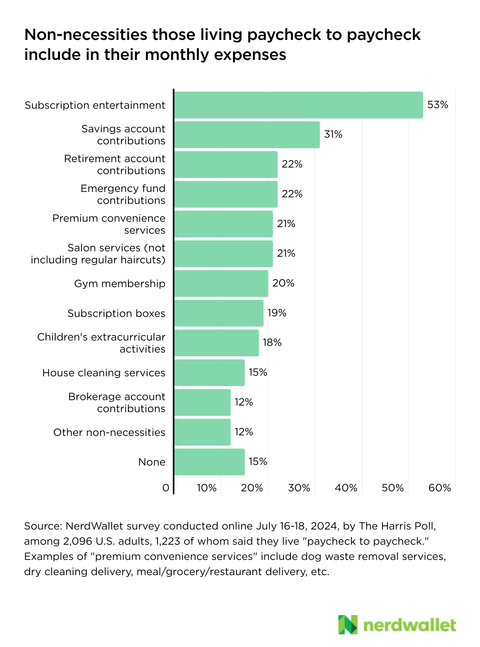Living paycheck to paycheck: A hardship or good budgeting?
By Elizabeth Renter, NerdWallet
Google “paycheck to paycheck” and you’ll be flooded with statistics that seem a bit suspect to an economist’s eye. Diving deeper into the spending habits of people who say they’re living with every dollar spoken for, it’s clear we’re not all defining paycheck to paycheck quite the same way. And it’s clear that some who assign themselves to this group could just be very efficient budgeters.
More than half of Americans (57%) say they’re currently living paycheck to paycheck, according to a nationally representative NerdWallet survey conducted online in July by The Harris Poll. In our survey, we didn’t define the phrase, as we wanted to measure the share of folks who identify with “living paycheck to paycheck” regardless of their finances. Then, we asked for some budget specifics.
Of those who said they’re living paycheck to paycheck, many regularly contribute to savings accounts (31%), retirement accounts (22%), or emergency savings funds (22%), all of which are important, but none of which are obligatory. And others include house cleaning services (15%) and subscription boxes (19%) among their regular monthly expenses.
In fact, 42% of Americans with household incomes of $100,000 or more say they live paycheck to paycheck.
So, what does living paycheck to paycheck mean?
By not defining the phrase in our survey, we hoped to understand how people feel about their financial condition more than whether they fit a tidy definition. Generally, living paycheck to paycheck implies all or most of your money from one paycheck is gone before or right in time to receive the next. And for many people, it implies some level of financial hardship.
But, it turns out depleting one paycheck just in time for the other’s arrival doesn’t have to mean financial dire straits. In fact, our survey found many people who place themselves in this category manage to spend on some monthly luxuries as well as have emergency savings and retirement accounts.

Addressing the feeling of financial constraint
When someone says they’re living paycheck to paycheck, it could be that they’re tightly budgeted. Emergency funds and retirement accounts, for example, are generally features of more financially secure households.
Some popular approaches to budgeting involve allocating your income toward various categories — 50% for needs, 30% for wants and 20% for savings and debt payments, in the case of the 50-30-20 budget, for example. And if 100% of what you bring in is earmarked for various purchases or accounts, you could consider yourself paycheck to paycheck, yet still doing quite well.
If you’re feeling like the well is dry when your next paycheck arrives, take a closer look at how you’re allocating your monthly income. You may find yourself on-track to long-term financial goals and able to afford some of the extras each month that enrich your life, even if your spending account dwindles toward the end of the pay period. If this is the case, and the tightly allocated budgeting feels fine, pat yourself on the back for being an astute financial manager. But if the dwindling feels bad, consider budgeting a buffer into that primary spending account or loosening the limits on your variable “wants” expenses each month. In this way, your “fun money” comes from one place, it rarely runs completely dry and you enjoy a bit of flexibility.
When living paycheck to paycheck means serious hardship
For some, however, living paycheck to paycheck happens because the money coming into the home just isn’t enough to cover the needs of the household. In this case, clever budgeting can only get you so far. According to the Federal Reserve, 63% of adult Americans in 2023 could manage an unexpected expense of $400 using cash, savings or a credit card they paid off right away. There’s a good chance the remaining 37% would describe themselves as living paycheck to paycheck.
Building a $400 emergency fund can be a tall order when you truly have nothing leftover at the end of the month. But every bit that gets you closer can be helpful. While you incrementally build a small safety net, have a financial hardship plan in place should things take a turn for the worse.
- Prioritize crucial expenses like housing, utilities, food and medical care.
- Contact your creditors and other bill collectors to explain your situation and ask about any hardship programs they offer.
- Identify local charities and organizations that can help in times of need and reach out to your state or county social services if you think you might qualify for government assistance.
The complete survey methodology is available in the original article, published at NerdWallet.
More From NerdWallet
Elizabeth Renter writes for NerdWallet. Email: elizabeth@nerdwallet.com. Twitter: @elizabethrenter.
The article Living Paycheck to Paycheck: A Hardship or Good Budgeting? originally appeared on NerdWallet.